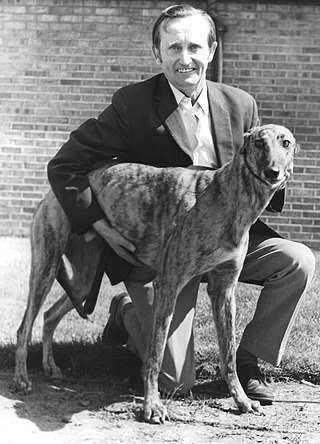Related Research Articles
The 1951 Greyhound Derby took place during June with the final being held on 30 June 1951 at White City Stadium. The winner Ballylanigan Tanist received a first prize of £1,500.
The 1937 UK & Ireland Greyhound Racing Year was the 12th year of greyhound racing in the United Kingdom and Ireland.
The 1938 UK & Ireland Greyhound Racing Year was the 13th year of greyhound racing in the United Kingdom and Ireland.
The 1946 UK & Ireland Greyhound Racing Year was the 21st year of greyhound racing in the United Kingdom and Ireland.
The 1947 UK & Ireland Greyhound Racing Year was the 22nd year of greyhound racing in the United Kingdom and Ireland.
The 1948 UK & Ireland Greyhound Racing Year was the 23rd year of greyhound racing in the United Kingdom and Ireland.
The 1950 UK & Ireland Greyhound Racing Year was the 25th year of greyhound racing in the United Kingdom and Ireland.
The 1952 UK & Ireland Greyhound Racing Year was the 27th year of greyhound racing in the United Kingdom and Ireland.
The 1953 UK & Ireland Greyhound Racing Year was the 28th year of greyhound racing in the United Kingdom and Ireland.
The 1954 UK & Ireland Greyhound Racing Year was the 29th year of greyhound racing in the United Kingdom and Ireland.
The 1955 UK & Ireland Greyhound Racing Year was the 30th year of greyhound racing in the United Kingdom and Ireland.
The 1956 UK & Ireland Greyhound Racing Year was the 30th year of greyhound racing in the United Kingdom and Ireland.
The 1957 UK & Ireland Greyhound Racing Year was the 31st year of greyhound racing in the United Kingdom and Ireland.
The 1967 UK & Ireland Greyhound Racing Year was the 41st year of greyhound racing in the United Kingdom and Ireland.

The 1972 UK & Ireland Greyhound Racing Year was the 46th year of greyhound racing in the United Kingdom and Ireland.
The 1975 UK & Ireland Greyhound Racing Year was the 49th year of greyhound racing in the United Kingdom and Ireland.
The 1980 UK & Ireland Greyhound Racing Year was the 54th year of greyhound racing in the United Kingdom and Ireland.
The 1982 UK & Ireland Greyhound Racing Year was the 56th year of greyhound racing in the United Kingdom and Ireland.
The 1984 UK & Ireland Greyhound Racing Year was the 58th year of greyhound racing in the United Kingdom and Ireland.
James Stanley Biss known as Stan (1892–1952) was a leading English greyhound trainer. He was a seven times winner of the Oaks in addition to winning the Scottish Greyhound Derby and Welsh Greyhound Derby.
References
- ↑ Fry, Paul (1995). The Official NGRC Greyhound Racing Yearbook. Ringpress Books. ISBN 186054-010-4.
- ↑ Dack, Barrie (1990). Greyhound Derby, the first 60 years. Ringpress Books. pp. 92–93. ISBN 0-948955-36-8.
- ↑ ""Sports in Brief." Times [London, England] 2 July 1951". The Times .
- 1 2 Comyn, John. 50 Years of Greyhound Racing in Ireland. Aherlow Publishers Ltd.
- ↑ Fortune, Michael. Irish Greyhound Derby 1932-1981. Victory Irish Promotions Ltd.
- ↑ Hobbs, Jonathan (2007). Greyhound Annual 2008, pages 153-154. Raceform. ISBN 978-1-905153-53-4.
- 1 2 Genders, Roy (1975). The Greyhound and Racing Greyhound. Page Brothers (Norwich). ISBN 0-85020-0474.
- ↑ "Monthly Greyhound Star (Remember When 1952) February edition". Greyhound Star.
- 1 2 Particulars of Licensed tracks, table 1 Licensed Dog Racecourses. Licensing Authorities. 1951.
- 1 2 3 4 5 Genders, Roy (1990). NGRC book of Greyhound Racing. Pelham Books Ltd. ISBN 0-7207-1804-X.
- ↑ ""G.R.A. Trust." Times, 3 Aug. 1951, p. 8". The Times .
- ↑ ""Sports in Brief." Times, 2 July 1951, p. 3". The Times .
- ↑ "1951". Greyhound Data.
- 1 2 Genders, Roy (1981). The Encyclopedia of Greyhound Racing. Pelham Books Ltd. ISBN 07207-1106-1.
- 1 2 "Remember When - September 1951". Greyhound Star.
- 1 2 3 Barnes, Julia (1988). Daily Mirror Greyhound Fact File. Ringpress Books. ISBN 0-948955-15-5.
- 1 2 Barnes/Sellers, Julia/John (1992). Ladbrokes Greyhound Fact File. Ringpress Books. ISBN 0-948955-22-8.
- ↑ "Greyhound Star (Remember When - January 1951)". Greyhound Star.
- ↑ "1951 Tote Totals, increase at 28 tracks". Vol. 7, no. 33. Greyhound Owner and Breeder. 18 September 1952.